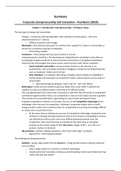Samenvatting
Book Summary Corporate Entrepreneurship and Innovation - Paul Burns (2020)
- Instelling
- Tilburg University (UVT)
For the course Introduction to Corporate Entrepreneurship the new edition (2020) of Corporate Entrepreneurship and Innovation - Paul Burns is part of the mandatory course material and the exam. The chapters 1, 2, 3, 4, 5, 6, 9, 10, 12, 13, 14 & 16 are summarized in this document. This minor course...
[Meer zien]





